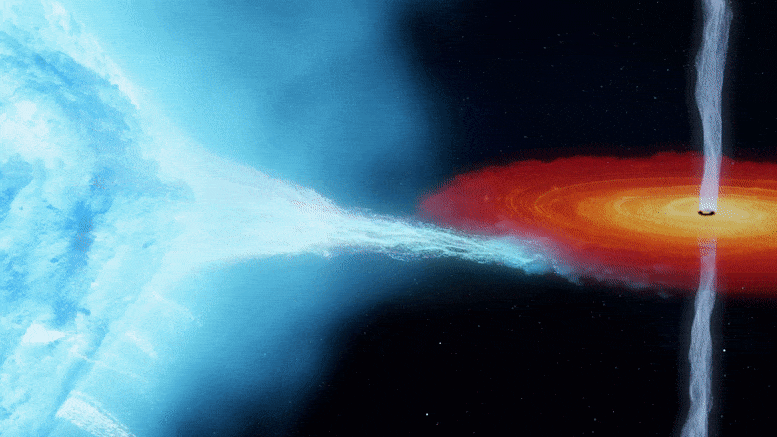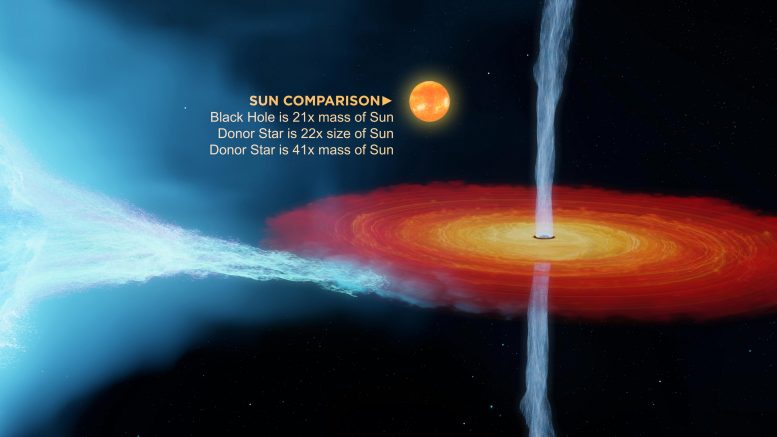
Weighing in at roughly 21 solar masses, the black hole in the X-ray binary system Cygnus X-1 is so massive that it challenges current stellar evolution models, a new study reveals.
Ultimately, the mass of a black hole is determined by its parent star’s properties and is generally constrained by the mass lost to stellar winds throughout its lifetime. If a black hole interacts with a binary companion star, the system emits X-rays and can sometimes form radio jets, which make the systems visible to electromagnetic observations as an X-ray binary.

A 21-solar-mass black hole in Cygnus X-1 defies current stellar evolution models, suggesting lower-than-expected mass loss.
Measurements from known X-ray binaries have shown that black holes in these systems all have masses below 20 solar masses (M☉), with the largest being 15-17 M☉. However, gravitational wave detections of black hole merger events have found more massive black holes, reaching upwards of 50 M☉, revealing a discrepancy that challenges current theories on black hole formation from massive stars.
Here, James Miller-Jones and colleagues present new observations of Cygnus X-1 — a well-studied stellar-mass black hole located in our Milky Way Galaxy — using the Very Long Baseline Array (VLBA). Between May 29 and June 3, 2016, they performed six observations (one per day) of Cygnus X-1 with the VLBA.
Using the new data and archival observations, Miller-Jones et al. refined the distance to the X-ray binary and found it to be farther away than previously estimated, thus raising the inferred mass of the system’s black hole to 21 M☉.
An animation showing the Cygnus X-1 system, consisting of a black hole in orbit with a giant star. Recent observations by radio telescopes have found the system is 20 percent further away than previously thought, implying the black hole is 21 times the mass of the Sun, making it the most massive stellar-mass black hole ever detected without the use of gravitational waves. Credit: International Centre for Radio Astronomy Research
The new measurements establish Cygnus X-1 as the most massive electromagnetically detected stellar-mass black hole currently known. According to the authors, for a black hole this massive to exist in the Milky Way, the mass lost through stellar winds during the progenitor star’s evolution must have been lower than what current models predict.
More on this research:
- First Black Hole Ever Detected – Cygnus X-1 – Is Much More Massive Than We Thought
- New Observations of First Black Hole Ever Detected Leads to Questions About the Universe’s Most Mysterious Objects
Reference: “Cygnus X-1 contains a 21-solar mass black hole – implications for massive star winds” by James C. A. Miller-Jones, Arash Bahramian, Jerome A. Orosz, Ilya Mandel, Lijun Gou, Thomas J. Maccarone, Coenraad J. Neijssel, Xueshan Zhao, Janusz Ziólkowski, Mark J. Reid, Phil Uttley, Xueying Zheng, Do-Young Byun, Richard Dodson, Victoria Grinberg, Taehyun Jung, Jeong-Sook Kim, Benito Marcote, Sera Markoff, María J. Rioja, Anthony P. Rushton, David M. Russell, Gregory R. Sivakoff, Alexandra J. Tetarenko, Valeriu Tudose and Joern Wilms, 18 February 2021, Science.
DOI: 10.1126/science.abb3363
Never miss a breakthrough: Join the SciTechDaily newsletter.
3 Comments
Why does a 21 stellar mass black hole challenge stellar evolution models? We know that black holes merge. Black holes also absorb any source of mass that comes near them. Unless you know for a fact that Cygnus X-1 is the result of the collapse of a single stellar object with no subsequent mergers with any other mass then it doesn’t challenge any model.
You do not understand because you can not. Our infantile math will go up to the veil but not pierce it. Hope for AI. This will break the veil.
“It challenges current models”
I wonder why … When we do know that at One time there existed a single “black hole” which contained within it the entire material we presently see in the entire universe, and the rest that’s too far to see.
And with that we can only imagine the forces at work within, till that moment when expansion overcame gravity , which resulted in “a rather big Big Bang” 🙂👍